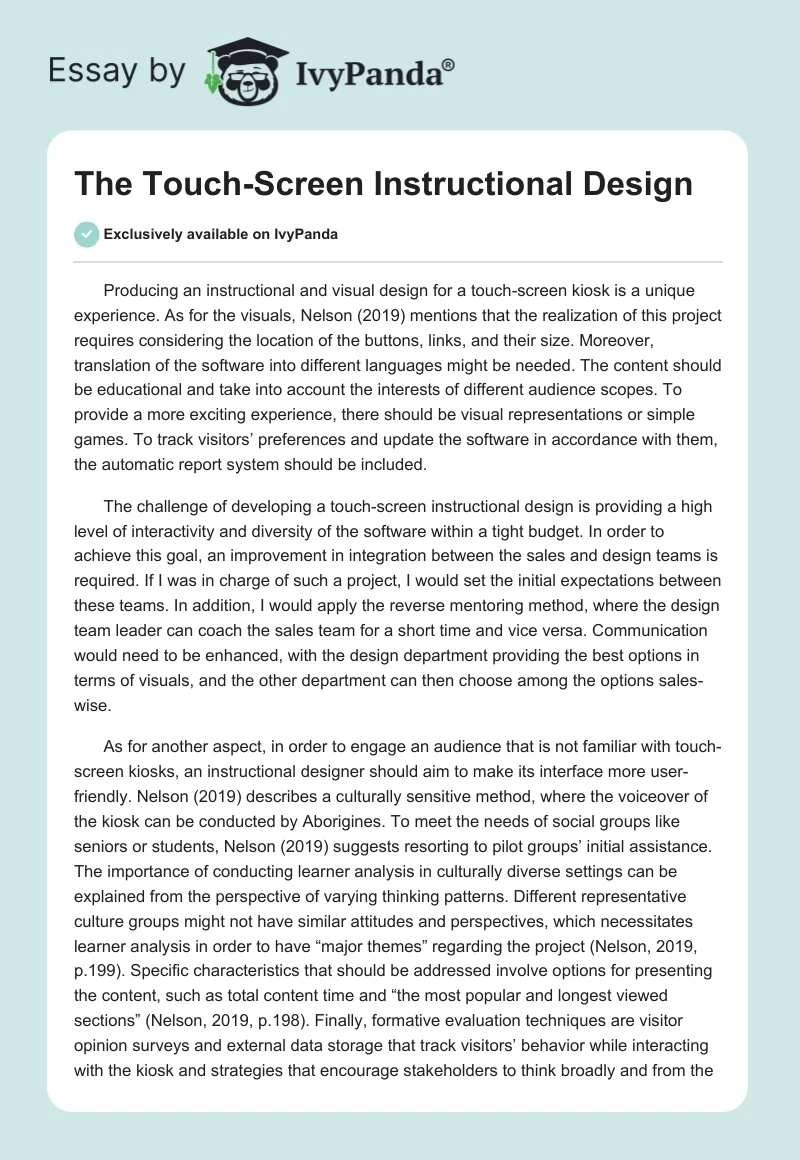Producing an instructional and visual design for a touch-screen kiosk is a unique experience. As for the visuals, Nelson (2019) mentions that the realization of this project requires considering the location of the buttons, links, and their size. Moreover, translation of the software into different languages might be needed. The content should be educational and take into account the interests of different audience scopes. To provide a more exciting experience, there should be visual representations or simple games. To track visitors’ preferences and update the software in accordance with them, the automatic report system should be included.
The challenge of developing a touch-screen instructional design is providing a high level of interactivity and diversity of the software within a tight budget. In order to achieve this goal, an improvement in integration between the sales and design teams is required. If I was in charge of such a project, I would set the initial expectations between these teams. In addition, I would apply the reverse mentoring method, where the design team leader can coach the sales team for a short time and vice versa. Communication would need to be enhanced, with the design department providing the best options in terms of visuals, and the other department can then choose among the options sales-wise.
As for another aspect, in order to engage an audience that is not familiar with touch-screen kiosks, an instructional designer should aim to make its interface more user-friendly. Nelson (2019) describes a culturally sensitive method, where the voiceover of the kiosk can be conducted by Aborigines. To meet the needs of social groups like seniors or students, Nelson (2019) suggests resorting to pilot groups’ initial assistance. The importance of conducting learner analysis in culturally diverse settings can be explained from the perspective of varying thinking patterns. Different representative culture groups might not have similar attitudes and perspectives, which necessitates learner analysis in order to have “major themes” regarding the project (Nelson, 2019, p.199). Specific characteristics that should be addressed involve options for presenting the content, such as total content time and “the most popular and longest viewed sections” (Nelson, 2019, p.198). Finally, formative evaluation techniques are visitor opinion surveys and external data storage that track visitors’ behavior while interacting with the kiosk and strategies that encourage stakeholders to think broadly and from the perspective of the customers and their requirements (Nelson, 2019, p.198). This way, the project becomes inclusive and offers more insights.
Reference
Nelson, C. (2019). Designing an interactive kiosk to celebrate World Wetlands Day. In P. A. Ertmer, J. A. Quinn, & K. D. Glazewski (Eds.), The ID casebook: Case studies in industrial design (5th ed., pp. 195-203). Routledge.


